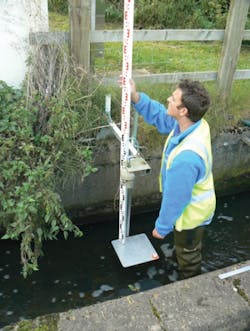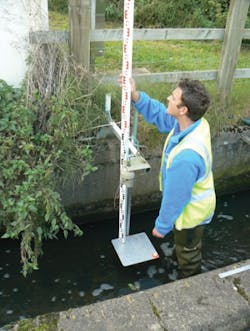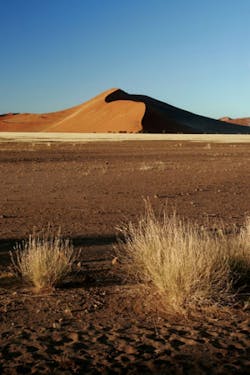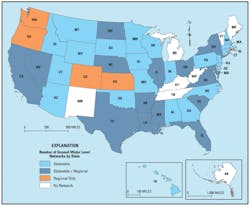Groundwater Supplies – Just How Much Do We Have?
Spurred by the European Union's efforts on the Water Framework Directive, the United States has formed a monitoring network to estimate the volume of useable groundwater available. Robert Schreiber looks at the progress of five states that have been selected to conduct a year–long trial.
Ensuring the sustainability of water resources remains one of the most difficult and pressing challenges the world faces in the 21st century. In the United States, the groundwater component of overall water resources represents the primary or sole source for a significant portion of the country, in particular the rural and agricultural sectors.
However, the lack of consistent monitoring of groundwater on a nationwide basis impedes the characterisation of this highly important water resource. In addition, several water–related federal laws and regulations address the need for groundwater monitoring, but no single U.S. law provides a centralised "driver", such as the European Union's Water Framework Directive.
To remedy this situation, several U.S. groundwater professionals banded together in a volunteer effort to formulate the framework for a national groundwater monitoring network. This effort, now into the initial stage of piloting, provides a fascinating example of water professionals coming together, many on a volunteer basis, to improve the state of understanding in the face of some daunting difficulties.
Groundwater monitoring network drivers
Several key factors drove this group of groundwater professionals – including some who had been involved in prior similar efforts – to come together in 2006 and initiate a new national network effort. The White House indicated strongly that assessment and management of water resources requires well–formulated monitoring systems for tracking trends, identifying problems, and estimating the volume of usable groundwater in the U.S. This specific aspect was simply expressed by the President George W. Bush (when he was Governor of Texas) to his advisory group at the time as: "Just how much groundwater do we have?"
Photo credit: William Cunningham, SOGW
While this may seem a simple question to answer, it goes straight to the mark by revealing the impact of not having a consistent and full–coverage national network.
Further to this, reports and surveys by various entities demonstrated the need for high–quality, trustworthy data for the basis for decision–making, in the face of ever–increasing stresses on groundwater. "Data gaps" were also found, following similar reporting and surveying of water resources and groundwater professionals, as well as interactions at stakeholder meetings. At the time, it was thought that the industry cannot manage effectively without being able to measure the resource [groundwater] with a sufficiently dense network, over time, in the most important aquifer zones.
At the same time, EU members were progressing toward fully implementing national water monitoring systems. These did in fact serve as excellent "models" for the step–wise design and implementation of a similar system in the U.S.
The U.S. coastal water quality–orientated National Monitoring Network was also emerging. This triggered the involvement of several groundwater professionals who helped design the coastal network's "groundwater component". They also identified the pressing need for a similar nationwide network, focusing purely on groundwater.
At the same time, the U.S. suffered from the occurrence of severe drought conditions and competition for over–stressed aquifer resources across multi–state regions. This sparked conflicts on the management of surface waters, affected by dwindling base flows and groundwater reserves threatened by saltwater intrusion and generally declining water levels. These conflicts helped focus attention on groundwater and the need to monitor it more effectively.
So what was done next? A steering committee was developed with a strong show of support through volunteer participation from federal, state, private sector, and academic areas. They determined that the best vehicle for this effort would be the Federal Advisory Committee on Water Information (ACWI).
This had already achieved success in areas such as sampling and analysis methods for water quality characterisation, development and promulgation of consensus–driven best–practices in hydrologic characterisation and analysis, facilitation of sustainable water resource approaches, and fostering the development of the coastal monitoring network.
Thus, ACWI fully supported the group of groundwater volunteers and approved formation of a new Subcommittee on Ground Water (SOGW). It was in January 2007 that ACWI and the new SOGW set forth the following goal to: "Develop and implement a national framework for groundwater monitoring, to facilitate assessments of the quantity of U.S. groundwater reserves, as constrained by groundwater quality."
The SOGW struggled at first with basic network design decisions, but soon made significant progress through a process that focused the work efforts on a set of "core groups". With support primarily from the U.S. Geological Survey (USGS) and also the U.S. Environmental Protection Agency (USEPA), the SOGW released an ACWI–approved framework document in August 2009, with recommendations for implementation of the network.
Pilot states and teething problems
Currently, implementation of its recommendations has entered the piloting phase, following an open solicitation for proposals that generated interest from 30 states and submittals by 12 states as part of nine piloting groups. The SOGW selected five of these groups for conducting a year–long piloting effort, including the states of New Jersey, Texas, Minnesota, Montana, and a combined two–state group from Illinois and Indiana. The SOGW, ACWI, and the many individuals and organisations involved in this effort are working toward full–scale, long–term implementation of the Network across the entire U.S. and its territories.
However, several challenges need to be addressed to achieve full–scale implementation of the concepts in the Framework Document. While piloting will help identify and address some of the difficulties; significant challenges are anticipated to remain. These include funding and cost–sharing, cross–border consistency, acceptability of field and laboratory data collection techniques, and even some basic network–design related elements.
As an example, the Framework Document provides some guidance on the selection of existing wells for inclusion in the Network, including example methods, case studies, and direct indications of threshold metadata requirements. Yet, aquifer–specific design decisions, such as spacing of monitoring wells and the extent of vertical coverage in layered systems, have been left as decisions for the participating data–providers (states, in most cases, but also tribal authorities and other similar entities).
The value of the pilot–testing has already highlighted such potential troubles. Recommended solutions to these issues will probably represent the most important aspects of this implementation stage.
The goal remains full participation of all states, tribes, and regional entities. Therefore, the SOGW has mapped out a plan that retains strong participation by member states, tribes, and regional entities, along with day–to–day operations by a "management and operations" group within the U.S. Geological Survey, as well as continued oversight and participation of the SOGW itself, which contains representatives from all sectors and many geographic areas.
The SOGW believes that this design will facilitate consensus–building as well as rapid attention to problems, if and when they arise, by building on the already–proven success of the SOGW partnership shown by development and publication of the framework document.
Moving forward
Continued collaboration of professionals dedicated to water resource monitoring is a key success factor. To facilitate this, the SOGW seeks an open dialogue with readers who may have been involved in such endeavors as the nationwide river–basin–based monitoring network implementations driven by the EU Water Framework Directives.
This is expected to help the SOGW and its various partner groundwater professionals in the U.S. as they move toward accomplishing the overall mission of Network implementation. In particular, any "lessons learned" from piloting and implementation of watershed–wide or aquifer–oriented monitoring networks, would be especially useful, including special attention key aspects including statistically adequate spatial and temporal density, cost–effectiveness of tested water quality parameters, and web data portal design.
Author's note:Robert Schreiber, P.E., BCEE, D.WRE is Co–Chair of the Subcommittee on Ground Water (SOGW), Federal Advisory Committee on Water Information (ACWI) and ASCE representative to ACWI. Co–authors of this article included William Cunningham, also co–chair on SOGW from USGS and Christine Reimer SOGW executive secretary from NGWA. For more information on the groundwater monitoring network, please email: [email protected]
More Water & WasteWater International Current Issue Articles
More Water & WasteWater International Archives Issue Articles



